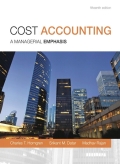
1.
Total variable cost and percentage of each cost to total variable cost per unit of each member firm of the trade union for September 2014.
Given information:
Firm A
Actual material used is 2.15 oz. per glass.
Actual material price is $5.00 per oz.
Actual labor hours used is 0.75 hours.
Actual wage rate is $14.50 per hour. Per DLH
Actual variable
Firm B
Actual material used is 2.00 oz. per glass.
Actual material price is $5.25 per oz.
Actual labor hours used is 1:00 hours.
Actual wage rate is $14.00 per hour. Per DLH
Actual variable overheads are $14.00 per DLH.
Firm C
Actual material used is 2.20 oz. per glass.
Actual material price is $5.10 per oz.
Actual labor hours used is 0.65 hours.
Actual wage rate is $14.25 per hour. Per DLH
Actual variable overheads are $7.75 per DLH.
Firm D
Actual material used is 2.60 oz. per glass.
Actual material price is $4.50 per oz.
Actual labor hours used is 0.70 hours.
Actual wage rate is $15.25 per hour. Per DLH
Actual variable overheads are $11.75 per DLH.
Industry’s Standard
Standard material used is 2.15 oz. per glass.
Standard material price is $5.10 per oz.
Standard labor hours used is 0.70 hours.
Standard wage rate is $12.50 per hour. Per DLH
Standard variable overheads are $12.25 per DLH.
2.
Price and efficiency variance of direct material and direct manufacturing labor and their percentage over industry benchmark.
3.
Advantages and disadvantages of using industry’s standard as benchmark.
Want to see the full answer?
Check out a sample textbook solution
Chapter 7 Solutions
Cost Accounting
- Please need answer the general accounting question not use aiarrow_forwardGroot Co. (GC) sells $1,200,000 of 6-year, 10% bonds at par plus accrued interest. The bonds are dated January 1, 2026 but due to market conditions are not issued until May 1, 2026. Interest is payable on June 30 and December 31 each year. The market rate of interest at time of issue is the same as the stated rate. Required The issuance of the bonds on May 1, 2026. Assume that GC has adopted a policy of crediting accrued interest payable for the accrued interest on the date of sale. Payment of interest on June 30, 2026. Payment of interest on December 31, 2026.arrow_forward1. Define working capital and explain its importance in financial health and liquidity management. 2. Assess how the matching concept and accrual basis affect the reporting of current assets and liabilities. 3. Using a hypothetical balance sheet (you may create one), identify at least 5 current assets and 5 current liabilities and analyze how changes in these elements affect liquidity ratios. 4. Recommend at least two strategies VinGrenDom Ltd. can implement to optimize working capital.arrow_forward
- Theron Interiors manufactures handcrafted cabinetry and uses a process costing system. During the month of October, the company started Production on 720 units and completed 590 units. The remaining 120 units were 60% complete in terms of materials and 40% complete in terms of labor and overhead. The total cost incurred during the month was $45,000 for materials and $31,200 for labor and overhead. Using the weighted-average method, what is the equivalent unit cost for materials and conversion costs (labor and overhead)?arrow_forwardGeneral Accountingarrow_forwardKamala Khan has to decide between the following two options: Take out a student loan of $70,000 and study accounting full time for the next three years. The interest on the loan is 4% per year payable annually. The principle is to be paid in full after ten years. Study part time and work part time to earn $15,000 per year for the following six years. Once Kamala graduates, she estimates that she will earn $30,000 for the first three years and $40,000 the next four years. Kamala's banker says the market interest for a ten-year horizon is 6%. Required Calculate NPV of the ten-year cash flows of the two options. For simplification assume that all cash flows happen at year-end. Based on the NPV which of the two options is better for Kamala?arrow_forward

 AccountingAccountingISBN:9781337272094Author:WARREN, Carl S., Reeve, James M., Duchac, Jonathan E.Publisher:Cengage Learning,
AccountingAccountingISBN:9781337272094Author:WARREN, Carl S., Reeve, James M., Duchac, Jonathan E.Publisher:Cengage Learning, Accounting Information SystemsAccountingISBN:9781337619202Author:Hall, James A.Publisher:Cengage Learning,
Accounting Information SystemsAccountingISBN:9781337619202Author:Hall, James A.Publisher:Cengage Learning, Horngren's Cost Accounting: A Managerial Emphasis...AccountingISBN:9780134475585Author:Srikant M. Datar, Madhav V. RajanPublisher:PEARSON
Horngren's Cost Accounting: A Managerial Emphasis...AccountingISBN:9780134475585Author:Srikant M. Datar, Madhav V. RajanPublisher:PEARSON Intermediate AccountingAccountingISBN:9781259722660Author:J. David Spiceland, Mark W. Nelson, Wayne M ThomasPublisher:McGraw-Hill Education
Intermediate AccountingAccountingISBN:9781259722660Author:J. David Spiceland, Mark W. Nelson, Wayne M ThomasPublisher:McGraw-Hill Education Financial and Managerial AccountingAccountingISBN:9781259726705Author:John J Wild, Ken W. Shaw, Barbara Chiappetta Fundamental Accounting PrinciplesPublisher:McGraw-Hill Education
Financial and Managerial AccountingAccountingISBN:9781259726705Author:John J Wild, Ken W. Shaw, Barbara Chiappetta Fundamental Accounting PrinciplesPublisher:McGraw-Hill Education





